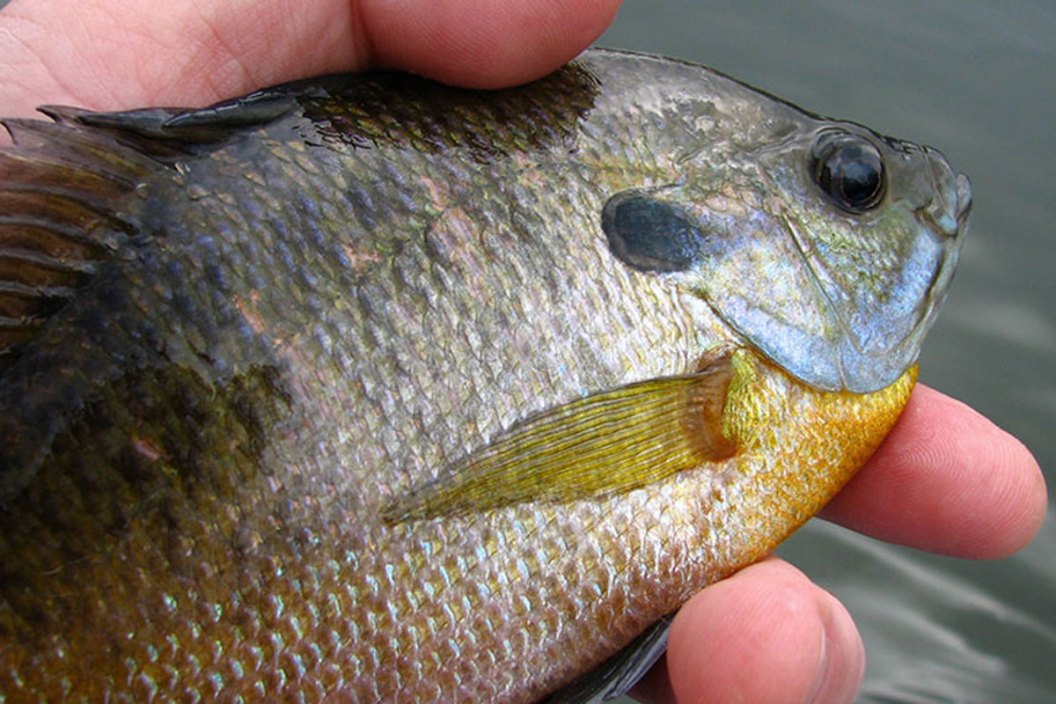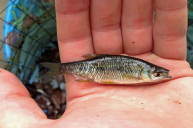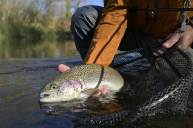It's said that the bluegill is the gateway fish for most freshwater anglers. Let's explore why that might just be true.
Let's face it, we've all walked up to the water's edge at some time in our lives, probably soon after winter, and the first fish we saw sitting on a bed was a bluegill.
What was our first reaction? We decided to wiggle a worm in front of it and see if we could catch it.
After that, it was game over.
For so many devoted anglers, it all started with the venerable bluegill. Also known as a bream, brim, sunny, or copper nose, this North American native species plays a key role in the freshwater food chain.
How much do you know about the fish found nearly everywhere?
Bluegill Appearance and Distribution
Most of you probably know what a bluegill looks like, but for those who have yet to discover them, we'll help you catch up. The bluegill, or Lepomis macrochirus, is a member of the sunfish family that features a distinctive black spot on its gill cover.
Overall the fish has a very unique coloring, sometimes with a blue-black or purple on its face, not to mention the dark, olive green colored bands down its sides, and typically a bright orange or yellow underside.
They're found all over the United States, often in the shadows of the nearest dock or glued to underwater structure.
According to the USFWS, "Prime habitat for bluegill include weed beds, o? deep points or in creek channels around sunken islands. They like quiet streams, ponds, lagoons and small to medium sized lakes. They can also be found in the shade of piers, swimming rafts, tree?shaded shores, where the overhanging limbs cast a shadow upon the water's surface and under, beside and within submerged aquatic vegetation or underwater brush piles."
Their documented range in North America extends from Canada to northern Mexico, as long as it's east of the Rocky Mountains. They've been introduced to waters nearly everywhere else, including Europe, Africa, Asia, Oceana, and South America.
Bluegill vs. Sunfish
The bluegill is most closely related to the orange-spotted sunfish and the redear sunfish, but they're differentiated by that distinct spot near the base of the dorsal fin. The orange-spotted sunfish is unique in that it prefers moving water around shallow water systems. They also prefer vegetated areas in slow backwaters or lakes, and can also be found in rivers.
The redear sunfish resembles the bluegill quite closely, except for its coloration. The redear sunfish also has faint vertical bars traveling downwards from its dorsal, but with a unique red band or half moon around the back edge of the gill plate.
Redears have an affinity for snails, their favorite food, which in turn gives them one of their nicknames: "shell cracker." The orange-spotted sunfish—which some call the pumpkinseed—is more like the bluegill in that it prefers to eat insects and other small invertebrates.
All three of these fish have a small mouth, live in fairly shallow water, and when the water temperatures warm up, their spawning beds show up in the water like craters on the moon. And that's likely the best opportunity to catch them.
Bluegill Fishing Gear
A bluegill is the fish that keeps on giving, as they always seem to cooperate when it comes to fishing for them.
Certainly factors like the time of day, weather, and the season can create issues around catching bluegill, but they are not picky eaters and feed year round.
Kids and beginners just starting out benefit from the simplest of systems, and that works just fine for bluegill fishing. Gear such as a closed-face spinning reel, the lightest of lines (anywhere from two to six pound test is plenty), along with some small hooks (size 5, 6, 7, or 8) will be all you need in terms of tackle.
For veteran anglers, fly fishing for bluegills and other panfish is one of the most exhilarating pastimes we ever undertook, and stands as great practice with our fly fishing gear. A light 3 or 4 weight rod and reel is more than enough.
Bluegill Bait
It might be better to try and list what you cannot catch a bluegill with, since the greatest reason why we all grew up fishing for them was their seemingly endless appetite.
Anyone who has fished off of a dock will tell you that they will eat almost any food scraps thrown into the water, including bread, corn, and even marshmallows.
If you're going to determine what it is that they naturally want, gathering live bait is almost as much fun as fishing for bluegill itself.
Start looking for crickets and grasshoppers, because these wiggly critters will always get a response from a bluegill. Other interesting choices include slugs, potato bugs, mealworms, and even maggots! Of course, the two most popular baits are small crayfish and earthworms.
It's important to point out that bluegill and other panfish are readily caught with small jigs, crankbaits, and spinners that easily fit into the palm of your hand.
Lure fishing can be a great way to get started, but it also requires some patience and practice. There's more to it than just dropping a worm on a hook into the water.
While many states have size and creel limits, most allow young children, veterans, and seniors to fish without a license, or at least for a decreased license fee. While most fishermen these days subscribe to catch and release, just about everyone understands that a bucketful of bluegill makes for a mighty fine meal.
That's not to suggest you can just take as many as you wish. Make sure to check your state and local regulations so that you know and understand the limits on your catch.
World Record Bluegill (and Its Closest Rival)
In the year 1950, an angler named T.S. Hudson of Birmingham caught a 4-pound, 12-ounce bluegill on Ketona Lake in Alabama that still stands as the IGFA world record.
But according to Fine Fishing, another fishermen from nearby Tarrant named Coke McKenzie was familiar with Ketona Lake bluegill fishing and was the previous record holder with a fish he landed in 1947 that weighed in at 4 pounds, 10 ounces.
McKenzie said, "It's a good thing I didn't clean the fish. We had company at the house, so I left it in the refrigerator in a pan of water. I planned on cleaning it in the morning, but the company stayed late, and I had to rush to work. We got to talking about the fish. The foreman and I got to arguing about its size. Then my boss heard how big it was. So he sent a man over to the house to get the fish. When the fish was weighed that afternoon it ran 4 pounds, 10 ounces."
McKenzie would later say, "I should have weighed that fish right away. I know it had to weigh at least 5 pounds. I'm sure it was larger than Hudson's fish that got weighed right away."
As far as bluegills go, they aren't always as small of fish as we think they are. For a species that starts out feeding on insect larvae in the calm waters of farm ponds, they sure can get big!
If you ask 10 different people for fishing tips for this fun and prolific game fish, you will get 10 different answers. Then again, that's the beauty of fishing: anyone can do it and we encourage all to try at some point in their life history.
Looking for a little more or even hot lunch for your hunting blind? Follow my webpage, or on Facebook and Twitter.
NEXT: RABBIT HUNTING 101: GEAR, STRATEGY, AND FINDING SPOTS
WATCH





